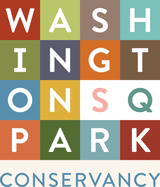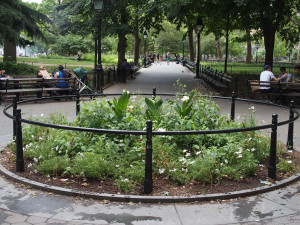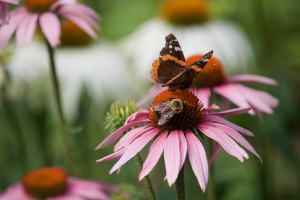Meet the Park’s Smallest Gardeners
At the four corner entrances to Washington Square Park you can find a round or oval garden bed. For the last few years these plots have served as ornamental beds, usually blooming with beautiful but fleeting tulips and other annual flowers. But all that changed in the fall of 2018 when Head Gardener Guilherme fulfilled a longtime dream for the Park. After watching beds of tulips become quickly bedraggled by too much heat and over-eager admirers, he knew there had to be a better option. Pollinator gardens were the answer.
Pollinators are insects or animals that fertilize plants. The majority of flowering plant species need these pollinators to make seeds and spread a new generation of plants. You can find all different kinds of pollinators in the Park: bees, birds, ants, and butterflies are just a few!
The pollinator beds are Park friendly for more than just their attractive nature. In previous years these beds have been filled with annual plants—plants that don’t come back after a single season. Each year new plants had to be purchased and planted to refill those beds, costing a significant amount of time and money. The tulips, which the Conservancy has planted since 2013, have been feeling the effects of climate change, only lasting about a week before the heat overpowers them. Flowers that are perennial in their native habitat have maybe one or two seasons in this busy urban environment. The new plants are perennials and will return season after season as long as they stay healthy. Delicate plants don’t hold up well in the corner beds so sturdier, but still beautiful varieties are a more sustainable choice.
Thanks to careful planning, the beds will be lush and blooming from March until November, starting with the petite but colorful crocuses and ending with coneflowers (Echinacea) and windflower
(Anemone). The display will be stunning, eye-catching, and complementary with the foliage in the rest of the Park, including the 36,000 bulbs planted along the center path this year. As things begin to bloom you’ll see some old favorites: windflowers, tickseed (Coreopsis), and windflowers to name a few. But the beds also provide the perfect opportunity to try out some new species. We’ll see beautiful Chocolate Shogun (Astilbe x Shogun) , which have a more striking color than some other species of astilbe you can find in the Park. Little rocket (Ligularia) and little lemon (Solidago) will bring bright splashes of happy yellow, and monkshood (Aconitum) bloom a vibrant and stunning violet. As these plants grow, some may thrive more than others and can be introduced to other spots in the Park. And while some new plants may need to be purchased to fill in spots caused by damage, much of what was originally planted will return just as beautifully each year so we can enjoy them season after season.


